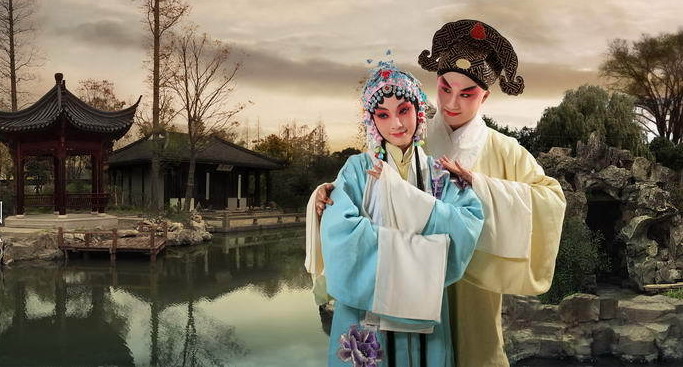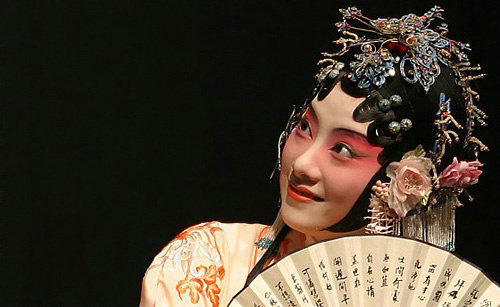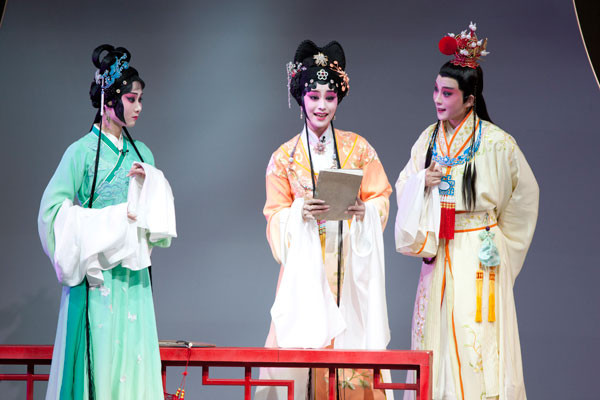
“月子灣灣照幾州,
幾人歡樂幾人愁,
幾人夫婦同羅帳,
幾人飄散在他州……”
吳王新宮裡,龍椅上的朱元璋,正靜靜的聽著一首吳歌。
那時,他剛在應天府稱帝不久,得知姑蘇城外崑山鄉間有位百歲壽星,便召其入宮詢問養生之法,末了不忘點唱崑山腔。只不過老壽星不善老家的崑山腔,只會更“土”一些的吳歌,於是,便有了開頭的一幕,而他用方言清唱的土歌謠,倒也令朱元璋稱快,為其撫掌,還賜其酒飲……
這則軼事,載於明代周元暐所撰隨筆《涇林續記》,雖非正史,但足以證明崑山腔——這一源自宋元民間、匯南北曲之長的唱腔,早在明代初年(14世紀60年代)就已名聲在外,而自那以後,崑山腔在聲樂家以及駢綺派作家的推動下,越來越趨於文雅。明代中晚期經過一番改良,始以“水磨腔”(“崑山水磨調”)演唱戲曲(“傳奇”劇本),並融入舞蹈、詩文、戲劇、美工等藝術之美,是為“崑劇” ,風行江南。明萬曆以後,逐漸傳至全國……

原文:
嘉隆間有豫章魏良輔者,流寓婁東鹿城之間。生而審音,憤南曲之訛陋也。盡洗乖聲,別開堂奧。調用“水磨”、拍捱“冷板”,聲則平上去入之婉協,字則頭、腹、尾音之畢勻。功深熔琢,氣無煙火,啓口輕圓,收音純細。
——(明)沈寵綏《度曲須知》
白話文譯文:
明朝嘉靖、隆慶年間,有江西豫章(南昌)人魏良輔,在蘇州婁東(太倉)、溫州鹿城一帶居住。他天生對音律敏感,且對當時南戲中的曲調、唱詞、板眼等不相協調極為不滿,於是改良戲曲中的違和之處,開創出一種新的唱法,稱為“水磨調”,其節拍近似清唱的“冷板曲”,平上去入四聲婉轉相和,且字頭、字腹、字尾發音搭配勻稱。唱功達致深厚時,有如熔煉金飾、雕琢玉器般精巧,亦如超凡脫俗;啟口發聲輕滑圓潤,歸韻收聲則純淨細膩。
——(明)沈寵綏《度曲須知》
英文譯文:
During the Jiajing and Longqing Emperor’s reign of the Ming Dynasty, there was Wei Liangfu from Yuzhang who once lived in Loudong and Lucheng. Being musically gifted, he was quite displeased with the incongruously-arranged melodies, lyrics, orchestration, etc. of the local operas, so he started to improve on them and finally codified a new vocal style named after “Shui-Mo” (literally “water-polished”). The rhythm of Shui-Mo is similar to that of a form of a cappella “Lengban” (literally “cold-clapping”) and the singing soundly fits the four tones in Chinese with the onset, nucleus and coda of each word on balance. A high-caliber singing can be likened to the art of goldsmithing or jade-carving and spiritually far beyond mundane. The voice always arises ethereally and tenderly and falls into rhyme clearly and tactfully.
— Handbook for Composing
by Chongsui Shen from the Ming Dynasty

2001 年,崑劇被聯合國教科文組織評為首批“人類口述和非物質遺產代表作”且位列榜首,在這批名單中,來自中國的只有崑劇一項……
英文原文 Kun Qu Opera Kun Qu Opera developed under the Ming dynasty (fourteenth to seventeenth centuries) in the city of Kunshan, situated in the region of Suzhou in southeast China. With its roots in popular theatre, the repertory of songs evolved into a major theatrical form. Kun Qu is one of the oldest forms of Chinese opera still performed today. It is characterized by its dynamic structure and melody (kunqiang) and classic pieces such as the Peony Pavilion and the Hall of Longevity. It combines song and recital as well as a complex system of choreographic techniques, acrobatics and symbolic gestures. The opera features a young male lead, a female lead, an old man and various comic roles, all dressed in traditional costumes. Kun Qu songs are accompanied by a bamboo flute, a small drum, wooden clappers, gongs and cymbals, all used to punctuate actions and emotions on stage. Renowned for the virtuosity of its rhythmic patterns (changqiang), Kun Qu opera has had a considerable influence on more recent forms of Chinese opera, such as the Sichuan or Beijing opera. The opera has suffered a gradual decline since the eighteenth century because of the high-level technical knowledge it also requires from its audience. Of the 400 arias regularly sung in opera performances in the mid-twentieth century, only a few dozen continue to be performed. The Kun Qu opera survived through the efforts of dedicated connoisseurs and various supporters who seek to attract the interest of a new generation of performers. — UNESCO
中文譯文: 崑劇 明朝時期(14至17世紀)崑劇在中國東南部的蘇州崑山一帶興起。其劇目源自民間流行的小戲,並最終演變成為一種主流的戲劇表演形式,它也是中國現存最古老、且仍活躍於舞台的劇種之一。 崑劇以生動的內容結構和音韻(崑腔)為特色,有《牡丹亭》、《長生殿》等經典劇目。其將唱念結合,輔以復雜的舞蹈步法、雜技動作和具有像徵意義的身體姿態。劇中主角常常是一位年輕男性和一位女性,另有年長的男性和各類滑稽角色,演員表演時著傳統戲服,伴奏樂器則有竹笛、小鼓、檀板、銅鑼和鐃鈸等,用來增強動作和情緒效果。崑劇的節律(唱腔)以精緻而著稱,它對其後誕生的中國戲劇——如川劇和京劇,均有過重大影響。 18世紀以後,崑劇逐漸衰落,這與它對聽眾水平要求過高有關。流傳至20世紀中葉的400餘出折子戲,如今常上演的只有數十出。崑劇傳承至今,得益於梨園行家與各界人士的支持,而他們也在找尋弘揚崑劇的新一代繼承者。 ——聯合國教科文組織

以下這段視頻,出自梅蘭芳大師1960年主演的崑劇藝術片《遊園驚夢》。
“遊園”與“驚夢”是崑劇《牡丹亭》中最為著名的兩齣,而視頻中的《皂羅袍》則是杜麗娘和侍女春香遊園時演唱的最為經典的段落。
【皂羅袍】
原來奼紫嫣紅開遍
似這般都付與斷井頹垣
良辰美景奈何天
賞心樂事誰家院 *
朝飛暮卷,雲霞翠軒
雨絲風片,煙波畫船
錦屏人忒看的這韶光賤
Zaoluopao
Here multiflorate splendor blooms forlorn
Midst broken fountains, mouldering walls
And the bright air, the brilliant morn
Feed my despair
Joy and gladness have withdrawn
To other gardens, other halls*
With twilight decors, clouds float
And in drizzles are breezed rowboats
Yet to come is my love
Less adorable so the spring is viewed
*前四句譯文摘自David Hawkes翻譯的《紅樓夢》(第23回)(詳見:The Story of the Stone, Volume I, Penguin Books, 1973, p.466)
© 譚譚演譯
用內容,成就觀眾的你、藝術的真、票房的喜